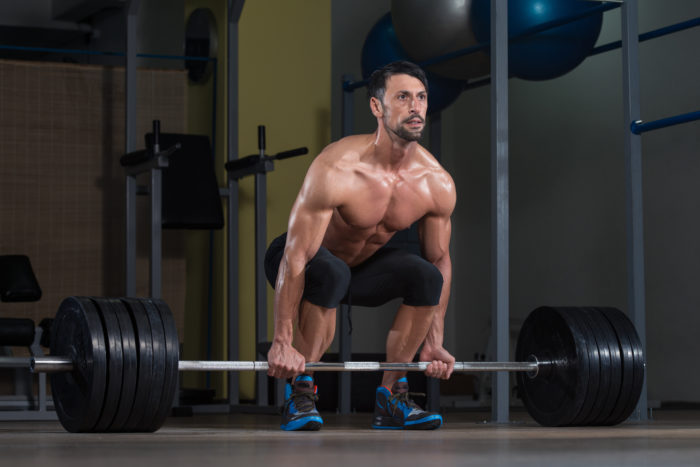Consider this your high-level overview of how to gain muscle mass.
Don’t be one of those guys who spends all his time tweaking his bicep burls and researching the best whey protein powder. Instead, focus on these big picture topics to help ensure you gain the most muscle possible.
We’ll start with the most important topic, your diet.
How to Gain Muscle Mass Principle #1: What to Eat to Gain Muscle Mass
You already know that to gain muscle mass you need to eat more calories, and specifically, more protein.
No surprises there, right?
But here’s something to keep in mind:
Most guys overestimate how much they need to eat.
Eat more, but don’t overdo it.

For some reason, a man hears the word “bulking” and immediately takes that as an excuse to eat everything in sight, from Doritos to Oreos to Cherry Garcia.
That’s not bulking, gentlemen. That’s getting fat.
The best place to start, when trying to gain muscle mass, is to eat 500 extra calories per day.
That should be enough to gain about 1 pound per week.
Don’t overestimate 500 calories. It’s the equivalent of about one additional small- to medium-sized meal.
Eat more carbs & protein and less fat.
If your goal is to learn how to gain muscle mass, then you’ll need to focus on eating more protein and carbohydrates.
These 2 macros are the most important when it comes to giving your muscles the nutrients they need to rebuild themselves to be bigger & stronger.
It’s still important to get some healthy fat (for hormonal reasons), but don’t overdo it. Keep fat to 30% of your calories at the most and focus on protein & carbs.
(This is why you should focus on lean protein sources, so you don’t overdo the fat and end up with way too many calories.)
How much protein should you eat?

Recommendations vary wildly, but the most common advice is to consume about 1 gram of protein per pound of body weight per day.
You probably don’t need quite that much—in fact studies show that 0.8 grams per pound of bodyweight per day is almost certainly enough. But for simplicity’s sake, try to get around 1 gram/pound of bodyweight/day, or a little bit less.
So if you weigh 200 pounds, that would mean getting 160-200 grams of protein/day.
If you weight 185, get 148-195 grams/day.
You get the idea.
Protein is important because it is, literally, the building block of muscle. Your body wouldn’t be able to make new muscle tissue without the amino acids you get from protein.
Eating enough protein also allows your body to stay in a positive nitrogen balance, which ensures that your body has t
Drink whey after workouts; otherwise, eat real food.
Whey protein & whey isolate powders are extremely popular among lifters, and for good reason. It’s the most bioavailable and fastest-absorbing source of protein you can get.
But does that make it better than eating real food, like chicken, fish, & steak?
No.
Well, let’s take a single step back. There is one situation in which whey protein is superior, and that’s immediately after lifting weights.
After lifting, your muscles will be broken down and in desperate need of nutrients. This means they’re primed to absorb new amino acids to rebuild themselves to be bigger & stronger.
So after lifting you want to make sure to get protein to your muscles ASAP. And whey protein is the fastest-absorbing protein you can get.
Moral of the story: drink a whey protein shake immediately after you lift weights.
Other than that, though, try to get your protein from real foods. Chicken, fish, beef, and so on.
In the long run, real foods will beat powders every time. Real foods contain vitamins, minerals, enzymes, and all that other good stuff to help fuel your body in ways that powders can’t.
In fact, you don’t really need whey at all. It’s nice to have after going to the gym, but if you don’t want to drink any protein shakes, you don’t have to. Just eat a big protein-heavy meal right after your workouts.
Drink enough water.
Being dehydrated by even 1-2% can cause a massive decrease in strength.
So drink up.
And remember: if you feel thirsty, that means you’re already dehydrated. It’s best to drink before you get thirsty so you never get dehydrated in the first place.
It’s a good idea to drink a big glass of water before going to the gym, and sip on a water bottle (or just hit up the fountain) regularly while you’re working out.
How to Gain Muscle Mass Principle #2: The Best Muscle Building Workout
Most guys make these 2 killer mistakes.
Make no mistake: to build massive amount of muscle, you need to lift weights.
Unfortunately, 90% of guys do this wrong. For starters, they follow routines like this:

- Monday: Chest
- Tuesday: Shoulders
- Wednesday: Arms
- Thursday: Lats
- Friday: Abs & Calves
- Saturday: Quads
A workout split like this will do absolutely NOTHING for you.
You could follow this routine for 5 years and at the end of that time you won’t be any bigger or stronger than you are now.
The other thing most guys do wrong is they do the wrong exercises.
In other words, they do the easy exercises.
Instead of squatting, they do leg press (or, even worse, leg extension)…thinking it’s the same thing.
Instead of pull-ups, they do lat pulldowns.
Instead of deadlifts, they do hyperextensions.
Instead of overhead press, they do shoulder raises.
You get the idea.
The RIGHT way to lift for muscle mass.
What you need to understand is that when it comes to building muscle, there are 2 main stages:
Stage 1 is building raw mass. This means adding new muscle by getting stronger.
Stage 2 is refining your physique. This means rounding out your weak areas and losing fat to reveal your muscles. (Note: Step 2 comes AFTER step 1. Not before.)
Mehdi from StrongLifts explains this concept really well:
Unfortunately most guys put the cart before the horse… and that’s like a sculptor trying to carve out a masterpiece from a tiny piece of clay – you just don’t have enough mass to work with. Similarly, split routines won’t work unless you’ve spent years building muscle mass. And that requires getting strong first…
In other words, exercises like shoulder raises aren’t going to do any good unless you first build up some raw muscle mass in your shoulders.
Which means that 99% of guys who want to gain muscle mass need to focus on one thing:
Getting stronger in key lifts.
By “key lifts” I mean compound movements, most of them using a barbell.
Key lifts includes:
- Squat (back & front variations)
- Deadlift
- Bench Press
- Barbell Rows
- Barbell Overhead Press
- Weighted Pull-Ups
Notice there isn’t a single bicep curl or ab raise to be seen in this list.
That’s because those exercises are WORTHLESS if you want to gain muscle mass.

Here’s the type of routine you should be following.
Instead of breaking your body out into 5-6 different splits (like shoulders, arms, abs, calves, etc.), you should structure your workouts like this:
Option A: Do full-body workouts.
Don’t know full-body workouts. They will kick your ass and pack on slabs of lean, mean muscle.
I love full-body workouts for a couple reasons:
- They force you to focus on compound movements like deadlifts & overhead press.
- They allow for maximum frequency; if you do 3 full-body workouts/week, you’re hitting all your major muscles 3x/week.
The only downside to full-body workouts is that you don’t have time to do a whole lot of volume; instead you’re probably looking at a couple heavy sets of the big compound lifts.
(And for most of us, that’s exactly what you need.)
Option B: Do upper-body & lower-body workouts.
If you want to add a little extra volume to your workouts, split your upper & lower body.
- The benefit of this is that you can spend more time hitting each half of your body. (For example, instead of just doing barbell rows for your back, you’ll have time to add chin-ups or cable rows.)
- The downside is that your training frequency per muscle group goes down. (While 3 full-body workouts will hit your legs 3x per week, splitting up your routines like this will hit your legs only 1.5x per week on average.)
Split routines like this work for more advanced trainers, so if you’re a beginner, stick to full-body workouts for now.
Option C: Do lower-body, upper body pushing muscle, & upper body pulling muscle workouts.
This is the most that I would recommend splitting up your workouts. It looks like this:
- Workout A: Upper body pushing (bench press, overhead press, etc.)
- Workout B: Legs (back squats, front squats, lunges, etc.)
- Workout C: Upper body pulling (rows, pull ups, deadlifts, etc.)
Here are the pros & cons of this style of workout routine:
- This split lets you really focus on your upper body in each workout; you’ll have time for bench press, overhead press, and a number of related accessory movements like shoulder raises, chest flies, dips, etc.
- The downside, once again, is that you’re reducing your training frequency (unless you work out 5-6 days per week, which is probably too often for most people).
My recommendation: start out with a full-body routine. Focus on getting stronger in the most important lifts. This is the fastest way to build muscle mass.
Focus on consistent strength gains.
When you lift weights, you should focus on one thing and one thing only:
Getting stronger in the key compound lifts.
If you squatted 275 pounds for 5 reps this week, next week try to get 275 for 6. Or 280 for 5.
Just get stronger.
Strength = muscle mass, gentlemen. A lot of articles will try to separate out “strength” from “hypertrophy” as if the 2 were completely different things.
They’re not.
Strength is where you get your foundation. Your mass.
Sure, doing 8-12 reps might be good for sarcoplasmic hypertrophy. But you know what?
A weaker guy might only be able to bench 185 for 8-12 reps. A stronger guy will be able to bench 225 for 8-12 reps.
Which one of those guys is going to have more muscle mass?
The strong one, obviously.
So don’t overcomplicate it.
Your goal in the gym is to do better than you did last week.
Rinse and repeat.
And in a year from now, you’ll be a beast.
How to Gain Muscle Mass Principle #3: Recovery & Other Muscle-Building FAQs
Let me know if you have more questions and I’ll add them to this section.
Do you need supplements to build muscle?
For the most part, you can skip the supplements.
The only ones worth checking out are whey protein, creatine monohydrate, and a few vitamins/minerals like vitamin D and magnesium.
All those NO2 powders, testosterone boosters, and anything else that claims to help build muscle?
It’s a scam.
Keep your workouts short & intense.
When lifting weights, 60 minutes is the maximum amount of time you want to be in there.
And 45 minutes is probably a better goal.
Too much time in the gym is counterproductive. It creates too much cortisol, which leads to muscle breakdown.
Make your workouts short, sweet, & intense.
Sleep, sleep, sleep.

This is important.
Your muscles don’t grow when you’re in the gym. They grow afterward, when you’re resting.
And the best rest you can get is good, deep sleep.
Getting 7 hours at night is the absolute minimum, and 8-10 is much, much better.
And if you can?
Squeeze in a nap here and there.
Bodybuilders do it all the time, because it works.
Sleep is CRITICAL, guys. Don’t overlook it.
For more tips, check out my blog post on post-workout recovery to help your muscles recover even better after intense sessions at the gym.
What about cardio?
A lot of guys are under the impression that cardio is the enemy. That it will cause you to lose all your precious muscle gains.
And to an extent, that’s true. You don’t want to be running 60 minutes a day if your goal is to gain muscle mass.
But a little cardio, especially some HIIT done on non-training days, is a great way to help keep the fat gain to a minimum while also keeping you in good shape.
Measure your progress if you want to improve.

Is your mass-gaining program working or not?
The only way you can tell (and the only way you can tell if you need to change something or not) is by measuring your progress.
Many guys choose only 1 metric to track…and that’s a problem.
Because if you only track 1 metric, you can easily miss the big picture.
So instead, you want to keep track of ALL these metrics. It’s a little more work, but it will give you a much more complete picture of how you are progressing.
- Scale – are you gaining weight? Ideally you will track not just weight but bodyfat, so you can be sure that you’re gaining muscle as opposed to fat.
- Mirror – do you look bigger & stronger? I highly recommend taking before & after pics. Trust me: 3 years from now, when you’re a muscle-bound monster, you’ll wish you had an old picture of yourself to see how far you’ve come.
- Strength – are you lifting heavier weights in the gym? This is a really important one. Use an app such as FitNotes to keep track.
- Measurements – at least measure your arms, shoulders, chest, thigh, and waist. Your goal should be for everything to grow except your waist.
Now Get Out There and Build Some Muscle
Stop reading shit online. Get out there and take action.
This is the only life you get, guys.
Do something awesome with it.